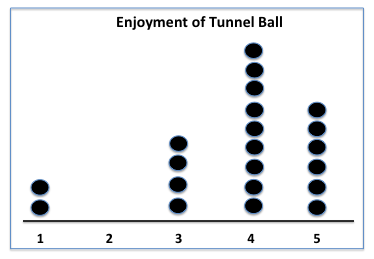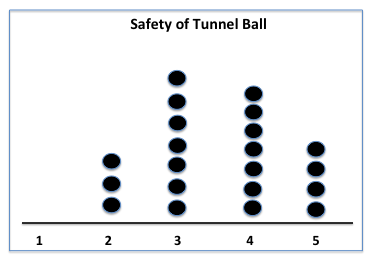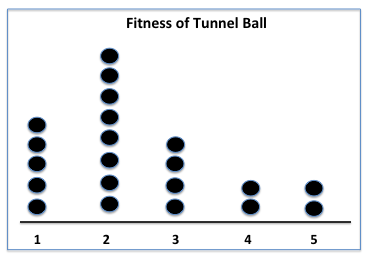The purpose of this unit is for students to design a PE/fitness game, use standard measures of length, and conduct a statistical investigation into the safety factors and the health benefits of their game.
- Understand how running a distance contributes to fitness and wellbeing.
- Create a personal benchmark for 1 metre and for 1 kilometre.
- Accurately use three measuring devices to measure a distance of more than 3 metres.
- Correctly record length measurements using abbreviations.
- Understand how many metres are in one kilometre.
- Understand that rules are designed to ensure fairness and safety.
- Create and write instructions for a PE/fitness game, giving consideration to fitness, safety and enjoyment.
- Accurately measure and record the length of a given outdoor space.
- Plan and carry out a statistical investigation, answering an investigative question and presenting findings.
- Recognise the need for small units of length measure (millimetres).
This unit of work assumes prerequisite knowledge gained at level one: the students can recognise the attribute of length, knows that measurement units are countable and that they can be partitioned and combined. When measuring length they realise that there should be no gaps or overlaps.
In these lessons the students are developing an understanding of a linear scale. They recognise that such a scale is made up of units of equal size that are known as ‘standard units’, because they are able to be easily understood by everyone.
The students learn to accurately reposition a metre ruler when required to measure a length longer than the ruler. In becoming familiar with metre and centimetre units of measure, the students learn to express parts of metres as centimetres and to use the abbreviations m and cm when recording length measures. They come to understand that 1000 metres are equal to 1 kilometre, and develop a personal benchmark for one metre and one kilometre.
Further to the development of measurement skills and knowledge, the students participate in planning and collecting appropriate data to answer a question that has been composed with the support of the teacher (as required). The students sort the data and presents these using a dot plot, whilst refining their understanding of the investigative process. They can answer the investigative question and can suggest consequences of their findings.
Associated Achievement Objectives
Health and Physical Education
Positive attitudes
- Participate in and create a variety of games and activities and discuss the enjoyment that these activities can bring to themselves and others.
Safety management
- Identify risk and use safe practices in a range of contexts.
This unit can be differentiated by varying the scaffolding or altering the difficulty of the tasks to make the learning opportunities accessible to a range of learners. For example:
- simplifying measuring tasks by using whole metres and half metres rather than a measurement scale
- brainstorming ideas for fitness games with students and having them choose one of the ideas as a starting point for their work
- providing opportunities for students work in tuakana/teina pairs, in small groups, or with the support of the teacher, as needed.
The focus of this unit is designing a PE/fitness game. Encourage students to consider their friends and classmates when planning, and to create a game that will appeal to them and be fun to play. This could be achieved by incorporating favourite elements from other games, or items of current interest. Elements of traditional Māori games such as Kī-o-Rahi, Tapuae and Mā Whero could be used as well.
Te reo Māori vocabulary terms such as inea (to measure), rūri (ruler), and tākaro (game) could be introduced in this unit and used throughout other mathematical learning.
- Metre rulers
- 1 centimetre cubes
- Retractable tape measures of at least 10 metres in length
- Measuring wheels
- PE equipment including small and large balls
- Chalk
Whilst this unit is presented as a sequence of five sessions, more sessions than this will be required between sessions 3 and 4. It is also expected that any session may extend beyond one teaching period.
Session 1
This session is about playing a familiar game and evaluating its health benefits and safety considerations.
Students of this age may be challenged to accurately measure their pulse rate. Therefore these lessons use an alternative ‘indicator’ of the effects of exercise: that is that the intensity of worthwhile exercise should prevent you from singing, but should not prevent you from talking.
SLOs:
- Understand how running a distance contributes to fitness and wellbeing.
- Create a personal benchmark for 1 metre.
- Accurately use three measuring devices to measure a distance of more than 3 metres.
- Correctly record length measurements using abbreviations.
- Understand how many metres are in one kilometre.
- Establish a person benchmark for 1 kilometre.
Activity 1
Begin the lesson by singing a favourite waiata. The aim of the lesson is not to learn a new waiata, so consider using one your ākonga are already familiar with.
Activity 2
- Explain to the students that they will be undertaking their regular fitness run (a distance of up to half a kilometre). Discuss the possible effects/benefits of this, and elicit specific statements. Possible responses could include “we get puffed”, “our heart beat/pulse speeds up”, and “it’s good for us”. In response, explain that the increase of beats per minute (bpm) is because their body physically needs to circulate oxygen more quickly as they exercise. Science has shown this is good for us.
Explain that today, when they each return from their run they should (individually) immediately sing the waiata from activity 1 (above), and then talk to a classmate about their run. - Have students complete their run and this task.
- Ask: ‘Who was able to sing the waiata immediately?’
‘Who was able to talk to their classmate?’
Count the responses for each and record these on the class chart. Discuss the results, explaining that being unable to sing immediately shows that they exercised well and their bodies will benefit.
Activity 3
Ask, “How far did you run today?” and “How can we find out?”
Make available 1 centimetre cubes, meter rulers, a 10 metre + tape measure and a measuring wheel.
Have the students share what they know about the metre ruler. Establish that it is called a metre ruler. It is 1 metre long. If centimetres have already been introduced and used, have students line up 1 cm cubes along the ruler to confirm that 1 metre = 100 centimetres.
Activity 4
Develop a personal benchmark by asking: “Who can jump 1 metre?”
Have student pairs measure a 1 metre length on the carpet/floor, marking this with chalk.
Highlight that the measure begins at 0 and ends at 100. Discuss the ‘extra’ space at each end of the ruler.
In their pairs, have students check if each person can jump 1 metre. A tuakana/teina model could work well here.
Agree that when we think about how big 1 metre is, we can think of it as one big personal jump.
Activity 5
- Introduce the tape measure and measuring wheel, explaining and showing how each measures 1 metre and multiples of 1 metre.
Highlight the 1 metre personal benchmark by asking:
If the tape measure is 10 metres, about how many of your jumps is that?
If we measured 100 metres with the wheel, about how many of your jumps is that? - Write ‘standard measure’ on the class chart and ask what it means. Elicit responses and point out that standard units have been created to allow consistency and communication of measures. We understand each other’s measurements if we use the same measures.
Explain that the standard units used in New Zealand, and in most countries in the world, are metric units. Some students may be familiar with the use of feet and inches, and could share their knowledge at this point. Discuss possible situations in which a standard measure might be useful (e.g. travel, building). You might be able to make links to community members (e.g. builders) or favourite hobbies (e.g. sprinting). Consider also how links might be made to your cultural context. - Write centimetre, metre and kilometre on the class chart. Explain that when we write them often, we want a quick way to record them. Model cm, m and km abbreviations. Students may mention that people often refer to "ks" when talking about kilometres.
Activity 6
Have a student model both the correct and an incorrect way to measure using a metre ruler. This could be completed in pairs. Highlight how to mark the beginning and end of the measure and how to correctly replace the metre ruler, when measuring a distance greater than 1 metre.
Have several students measure a length that is more than a metre, read the measure aloud, and record this on the class chart.
Model examples of parts of a metre as well, for example 2 ½ m.
Activity 7
Explain that students will pair up (tuakana/teina) and participate in two measuring tasks to become familiar with the measuring tools. Emphasise that their recording should use the correct abbreviations.
Show and have students make a recording sheet, as demonstrated below. Alternatively, you may feel it would be more effective to provide some, or all, of your students with a graphic organiser to be used in this activity.
Measurement
from ... toMetre ruler Measuring tape
Have students measure at least three different lengths around the classroom, hall, or other designated area, using a metre ruler and a measuring tape. They should that they get the same measure using each tool.- Clarify the exact fitness course route, the start and end points, and set relevant boundaries. Have student pairs take turns using the measuring wheel to measure the distance around the course and to then record the result.
Activity 8
Conclude the session by sharing measurement results and reviewing the fitness course distance. Discuss how many metres in 1 kilometre. Estimate and calculate together the number of times they would need to run around the fitness course to cover a 1 kilometre distance. Establish a rough benchmark for 1 kilometre. (For example, 1 kilometre is 5 times around the fitness course.)
Session 2
This session is about recognising that rules that address fairness and safety, help to ensure that a PE/fitness activity is enjoyable. As students design a PE/fitness activity, they learn more about accurately measuring outdoor spaces.
SLOs:
- Understand that rules are designed to ensure fairness and safety.
- Pose an investigative question.
- Create and write instructions for a PE/fitness game, giving consideration to fitness, safety and enjoyment.
- Accurately measure and record the length of a given outdoor space.
Activity 1
Begin with a fitness run.
Activity 2
Explain that the class is going to play a favourite PE game (for example: Ki-o-Rahi, Tunnel ball, Scatter Ball). Together, list the rules on the class chart.
Ask: Which of the rules are about making the game fair? Write F beside these. Discuss that fairness makes the game more enjoyable for everyone.
Ask: Which of the rules are about making the game safe? Write S beside these. Discuss any anomalies. If there are no specific safety rules, list some generic ones.
Activity 3
Return to the class, review the enjoyment of the game and ask if playing the game will make them fit. Discuss why/why not. Refer to the “talk/sing measure” from session 1.
(The response may be, “No, because it didn’t make me puff and I could sing.”)
Review the list of rules and confirm the fairness (F) and safety (S) decisions made earlier.
Highlight the importance of games and activities being safe and enjoyable. Ask if any other safety rules should be added and why.
Activity 4
- List on the class chart, the words ‘enjoyment, fitness and safety’.
- Suggest that students will work in pairs or small groups to create their own PE/fitness games. Through discussion, lead students to pose an investigative question. For example:
‘Can we design a game or activity that keeps us fit, is enjoyable and is safe?’
Record this on the class chart/modeling book. - Explain that students will be using an outdoor space with suitable boundaries, for example, the school tennis courts. Large balls and small balls will be made available. (Make other equipment available, as appropriate.)
- Clarify the task. Students will work in pairs or small groups to:
- Measure and record the size of the designated outdoor space (using skills learned in Session 1.)
- Invent a simple game that the class can play.
- Write down clear instructions and rules, checking for safety and fairness.
- Set time limits and clarify expectations. Have students complete the task.
Activity 5
Have groups swap game instructions with another group. Have them read, critique, seek clarification and suggest refinements or improvements to the other’s game design. You may wish to come up with guidelines and/or a rubric for students to use during this. The groups may wish to play each other’s games as well.
Give time for these adjustments to be made.
Activity 6
Review pair measurements for the outdoor space. Tennis courts are about 23.8m x 8.2m. Remind students that 1000m = 1 km. Estimate together the number of times the length of the court would need to be run to achieve the length of 1 kilometre. (eg. Round up to 25m. 25m x 40 = 1000m) Together calculate the number of lengths of the tennis court needed to run 1km.
Students may use this as a 1 kilometre benchmark. You could also consider other known lengths such as from the school gate to the walking pou, or other local community locations.
Session 3
This session is about creating a simple questionnaire to evaluate each group's activity, and learning about dot plots.
SLOs:
- Plan data collection.
- Collect data by trialing and evaluating an activity on its fitness, safety and enjoyment values.
Activity 1
Begin with a fitness run.
Activity 2
- Review the investigation question recorded on the chart in Session 2.
Ask the students how they should gather the data to answer the question. Guide discussion and agree on a simple evaluation form to be completed by the class after playing each game. For example:
The name of the game: ________________________________
Circle for each: 1 (not so good) 2, 3, 4 or 5 (excellent),
Enjoyment: 1 2 3 4 5
Fitness: 1 2 3 4 5
Safety: 1 2 3 4 5 - Print off the evaluation or have students copy this and practice using it by completing an evaluation for the game played at the start of Session 2.
Activity 3
Working together (mahi tahi model), collate and present the data using three dot plots. For example:



Discuss the dot plot features, the results, and draw conclusions.
Activity 4
For the remainder of the session, and for sessions to follow, have students participate in and evaluate each other’s games. Each group of students will collect the data for their game to analyse and present in Session 4.
Session 4
This session is about student groups sorting the data from their classmate’s evaluations of their activity and presenting the findings.
SLOs:
- Sort and display category data.
- Answer an investigative question.
Activity 1
Begin with a fitness run.
Activity 2
Make available pencils, paper, and sets of data for each pair activity.
Have students work in their groups to sort their data and to discuss their findings. Each student should create three dot plots to present their data, record their own findings and should answer the investigative question in their own way.
As students work, have them record on a small poster, their knowledge of centimetres, metres and kilometres, the relationship between them, and explain why we have standard measures.
Session 5
This session is about communicating investigation findings to others and sharing their understanding of standard measures of length.
SLOs:
- Present findings.
- Review and reflect on the investigative process.
- Review and reflect upon measurement learning.
- Discuss the need for small units of length measure and introduce millimetres.
Activity 1
Begin with a fitness run.
Activity 2
- Have each group present their findings about their game to the class. Allow time for other students to provide feedback.
- Together, as a class:
- Summarise on the class chart conclusions about safety, enjoyment, and fitness.
- Reflect on the investigation process and suggest ways it could have been improved.
Activity 4
Arrange the length measurement tools in front of the students.
Have individual students share their learning about each of the tools.
Ask which tool would be used to measure small lengths.
Introduce the millimetre measure for tiny lengths.
Conclude by reviewing personal benchmarks for (1cm), 1m and 1km.
Dear parents and whānau,
In mathematics we have been measuring distances and learning about metres and kilometres in particular. Ask your child to show how big a centimetre and a metre is, and to tell you about how big a kilometre is.
Please take opportunities to talk about and use these measurements: for example, measure and mark in pencil on a door frame, the height in metres and centimetres of each family member, or, when you are next travelling in the car, point out the speedometer and explain to your child how you know when the car has travelled 1 kilometre.